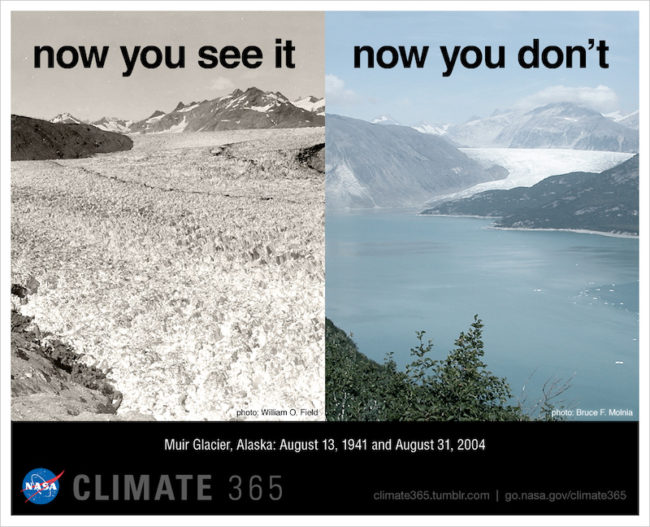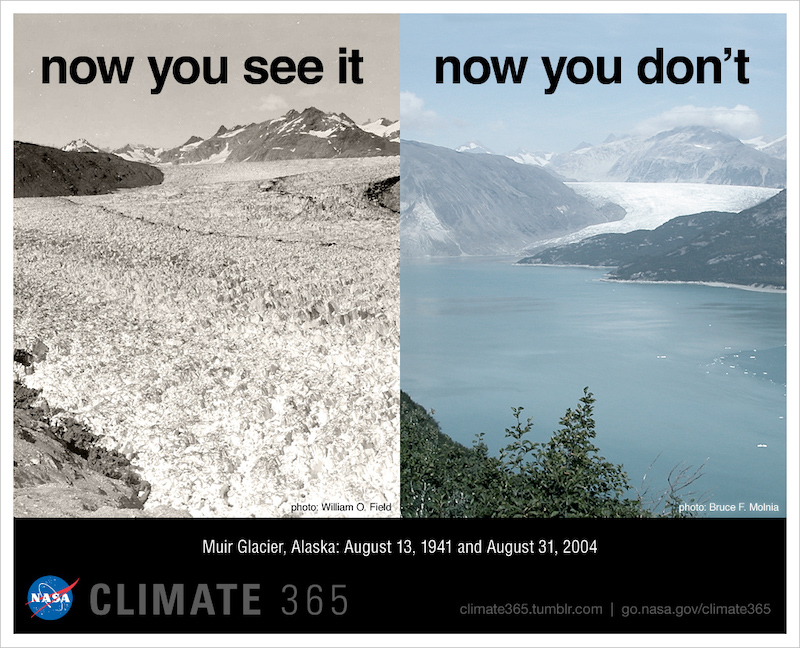
In a warming world it is perhaps inevitable that Glaciers will be greatly impacted, hence several new studies revealing that the ongoing measured decline will result in the glaciers being mostly gone by 2100 is not a surprise for many. A couple of new studies have arrived to become yet more data that shouts very loudly that we can’t simply continue pumping out vast amounts of CO2 without impacting the environment.
So what has been published?
There are two new studies. Let’s briefly review each in turn.
Study 1: Modelling the future evolution of glaciers in the European Alps under the EURO-CORDEX RCM ensemble
Published within the Open Access journal “The Crypsphere” by Swiss and Dutch researchers on 9th April 2019, we learn the following about the Glaciers in the Alps…
… The evolution of the total glacier volume in the coming decades is relatively similar under the various representative concentrations pathways (RCP2.6, 4.5 and 8.5), with volume losses of about 47 %–52 % in 2050 with respect to 2017. … Under a strong warming (RCP8.5) the future evolution of the glaciers is dictated by a substantial increase in surface melt, and glaciers are projected to largely disappear by 2100 (94.4±4.4 % volume loss vs. 2017). …
Let me spell that out for you …
- 50% gone by 2050 … that’s just 31 years from now
- 90% gone by 2100
It might not sound like a big deal, and so it needs to be appreciated that the loss of glaciers will have a huge impact. Glaciers in the European Alps play an important role in the hydrological cycle, act as a source for hydroelectricity, and have a large touristic importance. When they are gone, then all of that changes.
Study Author Observations
… “Glaciers in the European Alps and their recent evolution are some of the clearest indicators of the ongoing changes in climate,” said Daniel Farinotti, a glaciologist at ETH Zurich in Switzerland and one of the research team….
…“In the pessimistic case, the Alps will be mostly ice-free by 2100, with only isolated ice patches remaining at high elevation, representing 5% or less of the present-day ice volume,” said Matthias Huss, a senior researcher at ETH Zurich….
But …
…Farinotti said: “The future of these glaciers in indeed at risk, but there is still a possibility to limit their future losses.”…
Study-2: Global glacier mass changes and their contributions to sea-level rise from 1961 to 2016
This second study, also by Swiss Researchers, was published in Nature on 8th April 2019.
Within this one we learn the following …
…Here we use an extrapolation of glaciological and geodetic observations to show that glaciers contributed 27 ± 22 millimetres to global mean sea-level rise from 1961 to 2016. Regional specific-mass-change rates for 2006–2016 range from −0.1 metres to −1.2 metres of water equivalent per year, resulting in a global sea-level contribution of 335 ± 144 gigatonnes, or 0.92 ± 0.39 millimetres, per year. Although statistical uncertainty ranges overlap, our conclusions suggest that glacier mass loss may be larger than previously reported11. The present glacier mass loss is equivalent to the sea-level contribution of the Greenland Ice Sheet12, clearly exceeds the loss from the Antarctic Ice Sheet13, and accounts for 25 to 30 per cent of the total observed sea-level rise14. Present mass-loss rates indicate that glaciers could almost disappear in some mountain ranges in this century, while heavily glacierized regions will continue to contribute to sea-level rise beyond 2100….
We know sea level is rising and that the rate at which it is rising is accelerating. What this new study reveals is that 25-30% of that sea level rise is down to melting Glaciers.
They illustrate their data as follows …

The above shows the regional glacier contributions to sea-level rise from 1961 to 2016. The cumulative regional and global mass changes (in Gt, represented by the volume of the bubbles) are shown for the 19 first-order regions (outlined with bold black lines). Specific mass-change rates (m w.e. yr−1) are indicated by the colours of the bubbles.
What do we actually learn here?
To translate all of this, what it tells us is this …
- Earth’s glaciers have lost over 9,000 gigatons of ice since 1961. That’s over 9 trillion tons.
- This has caused the sea level to rise by 27 mm (1.06 inches) in that period.
Why all these Swiss studies on Glaciers appearing this week?
Basically because the European Geosciences Union conference is happening in Vienna, Austria this week. Various European researchers have been presenting their studies in this forum. The journals have also timed publication to align with those presentations.
It makes the news because retreating and thinning glaciers are icons of climate change. These are the preverbal canaries-in-a-coal-mine keeling over as a warning to us all that we face danger and need to take immediate action.
Is anybody actually listening?
